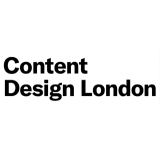This informal CPD article What is content design? was provided by Content Design London (CDL), a leading global content design agency working in the private, public and third sectors. Sarah Winters (was Richards, CDL’s founder) and her team at the Government Digital Service created the content design discipline by applying new techniques to their work.
“Get rid of the jargon!” is a battle cry of many content designers. It’s a core principle of content design. If technical terms are necessary, all you need to do is explain them the first time you use them. Include audiences new to the term. So let’s get down to basics: what is content design? Let’s break this down into…
- 1. Content
- 2. Design
- 3. Content design
1. Content isn’t confined to words
Content is a robust term and in this context, it simply means ‘a thing that is held, or included within something’.
Before the world of multimedia, content was largely words, perhaps with a couple of images added in. But now it’s so much more than that. To name but a few things, content could be:
- videos,
- posters,
- diagrams,
- calculators,
- online chatbots,
- podcasts.
2. Design as a way of thinking
The work designers do shape our lives at every scale, from the architecture of our cities to the objects and systems we use everyday. Design focuses on addressing the needs and expectations of its users.
Imagine using a teapot with the spout on the same side as the handle. That’s bad design, and it wouldn’t be usable.
3. Content design
Content design then. Following on from design, it’s a way of thinking. It’s using content to meet a user’s needs. As our Sarah Winters (was Richards) puts it, “It’s about using data and evidence to give the audience what they need, at the time they need it and in a way they expect.”
Meeting user needs with content design
“Content without discovery is like playing chess without the board” – Sarah Winters, founder of the content design discipline.
Content designers don’t move without research. This can include desk research, usability testing, expert research or any kind of research really. But there has to be data and evidence of audience needs and wants.
We also put ourselves in our user’s shoes and look at all the steps they take to fulfil their needs. Let’s use the example of someone who likes loose leaf tea. It could look a little something like this:
- 1. I’ve just used the last of my nice loose leaf tea,
- 2. I need more loose leaf tea,
- 3. I go online and I search for loose leaf tea,
- 4. I find a tea company website that sells it at a reasonable price,
- 5. I choose a bag of tea and add it to my basket,
- 6. I choose the delivery address,
- 7. I buy the tea,
- 8. The tea company sends me a confirmation email,
- 9. The tea company tells me it’s been dispatched,
- 10. The tea arrives at my chosen address.
Most of the steps above involve content. This is journey mapping. Content designers use it to look at how much work it is to get a result and what the user’s motivation is when they come to the content. We also look at what information a person needs at what point in the journey. There are a few user needs along this journey to buy tea.
For example:
- I need to find a website that sells loose leaf tea,
- I need an affordable option for loose leaf tea,
- I need to know the tea company has received my order,
- I need to know when it will be delivered.
All of these needs can be met with content at their given point in the journey.
And let’s not forget feelings and language: how are people talking about it? Content designers use the language their users are using. For the simple fact that they won’t find you, connect with you or trust you if they don’t. They also look at emotion to inform the tone their content should take. Still on tea here: it might be a light, fun tone using words such as ‘brew’ or ‘cuppa’.
Only once you’ve done all that research are you ready to create your content.
Working on content
Content design is a team sport. It’s a collaboration between researchers, designers, developers, service designers and product owners to figure out if something should be a content page, tool, calculator, poster – whatever the best solution might be.
The basic principle here is that user needs come first, then comes the format. We could also say that we figure out what the problem is before we create a solution.
We also share early and we share often. Good solid critique methods and feedback move the content forward. Then we iterate. There is absolutely no point doing all that research, if we don’t use it, learn from it and apply it to our content.
Using content design
So that’s content design in a large-ish nutshell. You can apply content design to anything you like. It’s simply an approach to producing content and meeting user needs.
We hope this article was helpful. For more information from Content Design London (CDL), please visit their CPD Member Directory page. Alternatively please visit the CPD Industry Hubs for more CPD articles, courses and events relevant to your Continuing Professional Development requirements.













